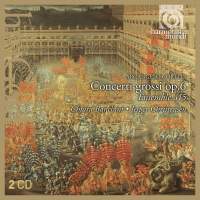Texte paru dans: / Appeared in:
|
|
|
Outil de traduction (Très approximatif) |
|
|
Reviewer: Nicholas Anderson
Never before have Corelli 's 12 Concerti grossi, Op. 6 been so plentifully represented on disc. This new set from Ensemble 415 joins ten others, no less, already in The Classical Catalogue. Unlike its fellow recordings on period instruments, however, this one takes as its starting point significant remarks by Corelli's German contemporary , Georg Muffat, contained in the preface to a collection of his own concerti grossi, the Ausserlesene Instrumental-Musick (1701). There, Muffat recalls, he had heard , some while earlier, several of CorelIi's concertos played by a great number of instrumental players . But though Muffat enters into details concerning continuo grouping he does not tell us precisely how many musicians were involved in the performances . Greater light is shed on this aspect by the account books of Corelli's patrons, Pamphili and Ottoboni which list all the musicians employed by their respective households. Using the list as a basis, the two directors Chiara Banchini and Jesper Christensen have fielded an orchestra of 16 violins, five violas, six cellos, five basses, four archlutes, a chitarrone, harpsichord and organ . This is more than twice the size of Trevor Pinnock's English Concert (Archiv) , for example, and substantially larger than Sigiswald Kuijken's Petite Bande (Deutsche Harmonia Mundi). The concertino group of two violins and cello remains the same, of course, though the composition of the continuo group frequently changes.
For the most part I enjoyed these
interpretations. Corelli's slow movements are noble pieces and they have a
gravity which is served well by a large group of instruments favouring a notably
slower tempo than has recently become the fashion. The opening Largo of
the Concerto No. I in D major is a good example of these qualities in Corelli's
style yet I felt that Banchini took it just a shade too slow for its own good .
More distinction might have been made between Largo and Grave, perhaps,
since both occur in the Concerti da chiesa (Nos. 1-8). But, on the whole,
Banchini's tempos are effective, allowing the music to breathe and enabling the
players to shape phrases gracefully. The dances of the Concerti da camera
(Nos. 9-12) are engagingly portrayed, as you will quickly find in the
Allemande and Corrente of the Ninth Concerto, for example, and there
are some pleasing arabesques from the plucked string continuo. Where I am
sometimes less happy is in the tonal quality of the upper string playing. There
is a tendency for it to sound scrappy and undernourished, and intonation is
variable, too . Nevertheless, I found this a price worth paying for an
interesting concept , plausibly realized and imaginatively executed with an
informed sense of style; the Largo (Pastorale) of the Eighth
Concerto has a good rustic flavour with appropriately emphasized drone effects .
The recorded sound is clear and spacious and the booklet-notes, by Christensen
himself, informative. |
|
|
|
|
|
Cliquez l'un ou l'autre
bouton pour découvrir bien d'autres critiques de CD |
|



